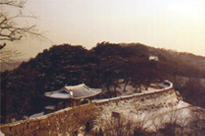 |
Gyeonggi Province is located in the central western part of Korea. It surrounds the metropolis of Seoul and city of Incheon, borders Hwanghae Province in the north, Gangwon Province in the east, South-Chungcheong Province in the south and the Yellow Sea in the west.
Gyeonggi Province is a fertile plain along the Han River that people have settled since the prehistoric period, as proven by the discovery of Old Stone Age sites in Jeongok-Ri, Yeoncheon-Gun, New Stone Age sites in Misa-Dong, Hanam City, and various Bronze Age sites.
During the 2nd century BC, the northern part of the Gyeonggi region is believed to have been the location of Jin country (òãÏÐ). Then, the Gyeonggi region came under the Mahan confederation. Of the 54 small countries (á³ÏÐ) of the Mahan confederation, 10 were located within Gyeonggi Province.
The strategic importance of Gyeonggi Province has remained unchanged since BC18, when King Onjow, the founder of Baekjae, designated Wirye Castle in Hanam the seat of a provincial government. By the mid-5th century, this region of the Han River had merged with Goguryeo and in 553 (14th year of King Jinheung) it became the territory of Shilla.
Thereafter, the Unified Shilla implemented a 9-state system and established the state of Hansan in the Gyeonggi Province region. In the post three-nation period, this region was ruled by Gungye.
Since the designation of Gaeseong as the royal capital by founding king Wanggeon of Goryeo, the Gyeonggi region has been center stage of Korean history.
The name Gyeonggi was established under the administrative jurisdiction of the Goryeo Dynasty. In 995 (14th year of King Seongjong, Goryeo), it established 6 Jeokhyeon (îåúã) and 7 Gihyeon (Ѳúã) around Gaegyeong. In 1018 (9th year of King Hyeonjeong, Goryeo) these two Hyeon combined and were formally named Gyeonggi, the regional outskirts of the capital city.
Originally, Gyeong meant ¡°capital city designated by the king¡± and Gi meant ¡°150 km of land in the four directions from where the king lived¡± The word Gyeonggi was derived from the Tang period when it ruled the vicinity of the capital region in Gyeonghyeon (ÌÈúã,îåúã) and Gihyeon (Ѳúã).
In 1069 (23rd year of Munjong, Goryeo), 39 Hyeon were transferred from Yanggwang (åÅÎÆ). Gyoju (Îßñ¶). Seohaedo (à¤úÔ³) and 13 Hyeon added, expanding Gyeonggi to a total of 52 Hyeon. A short time after, the region of Gyeonggi was reduced to the size that it was in the King Hyeonjong period during the Goryeo period.
In 1390 (2nd year of King Gongyang, Goryeo), Gyeonggi expanded to the size it was in 1069 (23rd period of King Munjong, Goryeo), with a total of 44 Hyeon, and became the first provincial organization. At that time, Gyeonggi was governed by separate Left-Province and Right-Province administrations.
The Joseon designated Hanyang as the new seat of government and redrew the boundary of Gyeonggi. During the rule of King Taejong, Left and Right Gyeonggi combined and were renamed Gyeonggi. The northwestern part, comprising Suan, Gokju, and Yeonan areas, came under the region of Punghaedo (ù¥úÔ³: Hwanghae Province) and the southeastern part, comprising Suwon, Yeoju, and Anseong, transferred to Gyeonggi to form the current regional jurisdiction.
The founding of the Joseon Dynasty and moving of the seat of government to Hanyang was the turning point in shaping the contours of Gyeonggi Province as we know it today.
|

